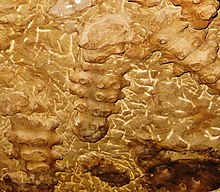Loading AI tools
Extinct order of sponges From Wikipedia, the free encyclopedia
Reticulosa is an extinct order of sea sponges in the class Hexactinellida (glass sponges) and the subclass Amphidiscophora.[1][2] Reticulosans were diverse in shape and size, similar to their modern relatives, the amphidiscosidans. Some were smooth and attached to a surface at a flat point, others were polyhedral or ornamented with nodes, many were covered in bristles, and a few were even suspended above the seabed by a rope-like anchor of braided glass spicules.[2][3]
| Reticulosa Temporal range: | |
|---|---|
 | |
| Fossils of Hydnoceras, a large dictyospongiid from the Upper Devonian | |
| Scientific classification | |
| Domain: | Eukaryota |
| Kingdom: | Animalia |
| Phylum: | Porifera |
| Class: | Hexactinellida |
| Subclass: | Amphidiscophora |
| Order: | †Reticulosa Reid, 1958 |
Reticulosans comprise the vast majority of Paleozoic hexactinellid diversity, though only a few species survived up to the Mesozoic.[2][3] They may include the oldest sponge body fossil in the world: Palaeophragmodictya, from the late Ediacaran (~555 Ma), was originally described as a reticulosan based on its mesh-like surface texture.[4] Ediacaran-type preservation has obscured any information about spicule structure, and some authors doubt that Palaeophragmodictya is a sponge in the first place.[5][6][7] Regardless, unambiguous reticulosans appear in the fossil record not much later, in the early Cambrian.[2]
Like most other glass sponges, reticulosans had a skeleton of unfused macroscleres reinforced with microscopic microscleres. Their macroscleres are often stauractines (four-rayed spicules, + shaped), though pentactine (five-rayed) or hexactine (six-rayed) spicules may be predominant in certain regions of the skeleton. The outer layer of the skeleton forms a regular mesh-like pattern, with incrementally smaller spicules filling in the gaps between larger spicules in a fractal pattern. The microscleres, when present, are simple bundled rods (paraclavules).[2][3]
The living glass sponge Sclerothamnus is sometimes compared to the reticulosan family Titusvillidae,[2][8] though it is more commonly placed in the family Tretodictyidae of the order Sceptrulophora.[9]
From the Treatise on Invertebrate Paleontology (2004), unless otherwise noted:[2]
Seamless Wikipedia browsing. On steroids.
Every time you click a link to Wikipedia, Wiktionary or Wikiquote in your browser's search results, it will show the modern Wikiwand interface.
Wikiwand extension is a five stars, simple, with minimum permission required to keep your browsing private, safe and transparent.